台达DVPLC用电位器的电压模拟传感器DVPSL模拟量输入成功程序
- 格式:docx
- 大小:1.97 MB
- 文档页数:7
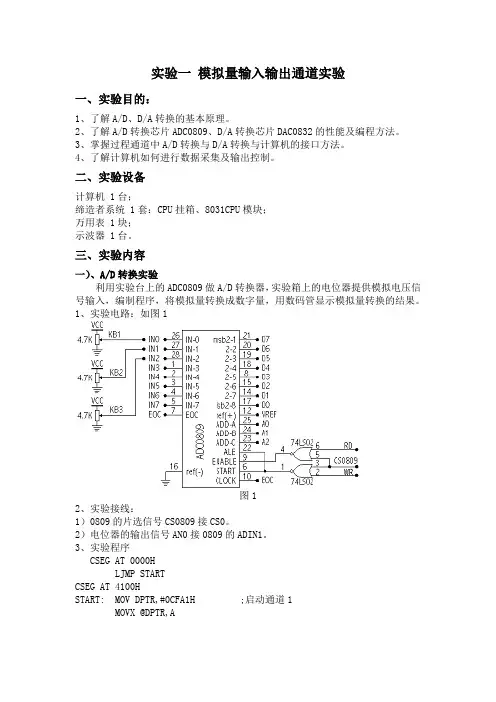
实验一模拟量输入输出通道实验一、实验目的:1、了解A/D、D/A转换的基本原理。
2、了解A/D转换芯片ADC0809、D/A转换芯片DAC0832的性能及编程方法。
3、掌握过程通道中A/D转换与D/A转换与计算机的接口方法。
4、了解计算机如何进行数据采集及输出控制。
二、实验设备计算机 1台;缔造者系统 1套:CPU挂箱、8031CPU模块;万用表 1块;示波器 1台。
三、实验内容一)、A/D转换实验利用实验台上的ADC0809做A/D转换器,实验箱上的电位器提供模拟电压信号输入,编制程序,将模拟量转换成数字量,用数码管显示模拟量转换的结果。
1、实验电路:如图1图12、实验接线:1)0809的片选信号CS0809接CS0。
2)电位器的输出信号AN0接0809的ADIN1。
3、实验程序CSEG AT 0000HLJMP STARTCSEG AT 4100HSTART: MOV DPTR,#0CFA1H ;启动通道1MOVX @DPTR,AMOV R0,#0FFHLOOP1: DJNZ R0,LOOP1 ;等待转换结束MOVX A,@DPTRMOV R1,ADISP: MOV A,R1 ;从R1中取转换结果MOV B,#100 ;求百位数据DIV ABMOV 50H,A ;存百位数据MOV A,BMOV B,#10 ;求十位数据DIV ABMOV 51H,A ;存十位数据MOV 52H,B ;存个位数据LOOP: MOV DPTR,#0CFE9H ;写显示RAM命令字MOV A,#90HMOVX @DPTR,AMOV R0,#50H ;存放转换结果地址初值送R0MOV R1,#03HMOV DPTR,#0CFE8H ;8279数据口地址DL0: MOV A,@R0ACALL TABLE ;转换为显码MOVX @DPTR,A ;送显码输出INC R0DJNZ R1,DL0SJMP DEL1TABLE: INC AMOVC A,@A+PCRETDB 3FH,06H,5BH,4FH,66H,6DH,7DH,07HDB 7FH,6FH,77H,7CH,39H,5EH,79H,71HDEL1: MOV R6,#255 ;延时一段时间使显示更稳定DEL2: MOV R5,#255DEL3: DJNZ R5,DEL3DJNZ R6,DEL2LJMP START ;循环END4、实验步骤1)从系统“开始”菜单进入“所有程序”,在“所有程序”中选择“Windows Virtual PC”,点击“Windows XP Mode”进入虚拟机系统。
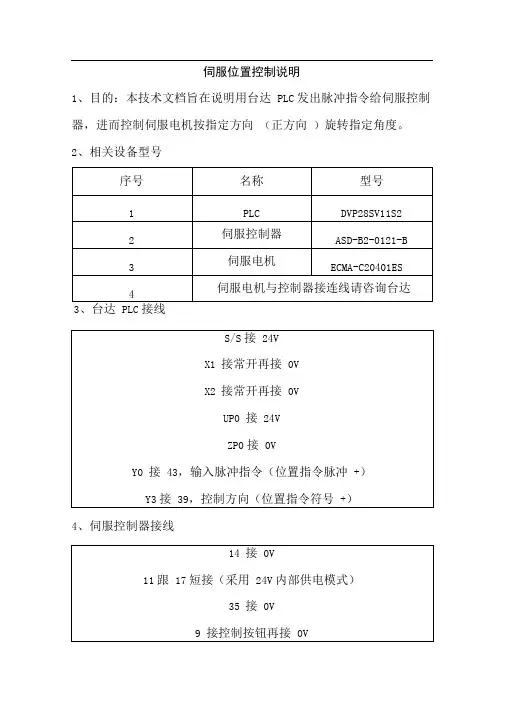
伺服位置控制说明
1、目的:本技术文档旨在说明用台达PLC发出脉冲指令给伺服控制器,进而控制伺服电机按指定方向(正方向)旋转指定角度。
2、相关设备型号
3、台达PLC接线
4、伺服控制器接线
43接Y3(正脉冲指令输入)
39 接Y3(正方向指令输入)
L1C接火线,L1C跟R 短接L2C接火线,L2C 跟S 短接注:伺服电机与控制器采用专用配线连接
5、PLC程序
6、伺服控制器设置(位置模式)
1. 恢复出厂设置:P2-08 设置参数为10,P2-10 设置为101, p2-15 设置为0, p2-16 设置为0, p2-17 设置为0 ,重新上电。
(不按上述设置,只改p2-08, 会报错)
2. 位置模式选择:P1-01 设置参数为00,重新上电。
设置P1-00为2,脉冲+方向模式。
3. 设置DI1为Servo On:P2-10设置为101(默认初始值就是101)
4. 设置电子齿轮比:根据功能具体要求确定合适的电子齿轮比。
这里我们设置为160。
设置P1-44 和P1-45。
5. 设置增益:P2-00,P2-02。
电机抖动,这个参数设置的要小些。
6. P0-02 :设置为01 脉冲指令输入脉冲数(电子齿轮比之后)
7、相关照片
图 1 伺服接线
图 2 PLC接线
ε S。
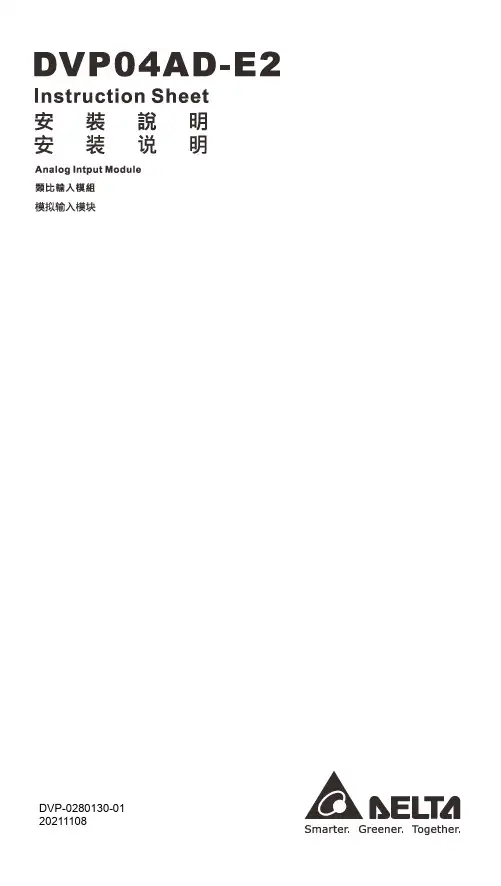
DVP-0280130-01 20211108………………………………………………………………… ENGLISH …………………………………………………………………Thank you for choosing Delta’s DVP series PLC. DVP04AD-E2 analog input module receives external 4 points of analog input signals (voltage or current) and converts them into 16-bit digital signals. You can select voltage input or current input by the wiring. In addition, you can access the data in the module by applying FROM/TO instructions or read the average value of channels directly by using MOV instruction (Please refer to allocation of special registers D9900 ~ D9999).EN DVP04AD-E2 is an OPEN-TYPE device. It should be installed in a control cabinetfree of airborne dust, humidity, electric shock and vibration. To preventnon-maintenance staff from operating DVP04AD-E2, or to prevent an accident from damaging DVP04AD-E2, the control cabinet in which DVP04AD-E2 isinstalled should be equipped with a safeguard. For example, the control cabinet in which DVP04AD-E2 is installed can be unlocked with a special tool or key. EN DO NOT connect AC power to any of I/O terminals, otherwise serious damagemay occur. Please check all wiring again before DVP04AD-E2 is powered up. After DVP04AD-E2 is disconnected, Do NOT touch any terminals in a minute. Make sure that the ground terminal on DVP04AD-E2 is correctly grounded in order to prevent electromagnetic interference.FR DVP04AD-E2 est un module OUVERT. Il doit être installé que dans une enceinteprotectrice (boitier, armoire, etc.) saine, dépourvue de poussière, d’humidité, de vibrations et hors d’atteinte des chocs électriques. La protection doit éviter que les personnes non habilitées à la maintenance puissent accéder à l’appareil (par exemple, une clé ou un outil doivent être nécessaire pour ouvrir a protection). FR Ne pas appliquer la tension secteur sur les bornes d’entrées/Sorties, ou l’appareilDVP04AD-E2 pourra être endommagé. Merci de vérifier encore une fois lecâblage avant la mise sous tension du DVP04AD-E2. Lors de la déconnection de l’appareil, ne pas toucher les connecteurs dans la minute suivante. Vérifier que la terre est bien reliée au connecteur de terre afin d’éviter toute interférence électromagnétique.Product Profile & DimensionUnit:mmExternal WiringNote 1: When performing analog input, please isolate other power wirings.Note 2: When the A/D module is connected to current signals, make sure you short-circuit “V+” and “I+” terminals.Note 3: If the noise is too significant, please connect FE to the grounding terminal.Note 4: Please connect the terminal on both the power module and A/D module to the system earth point and ground the system contact or connect it to the cover of power distribution cabinet. Note 5: If the ripples at the loaded input terminal are too significant that causes noise interference on the wiring, connect the wiring to 0.1 ~ 0.47μF 25V capacitor.I/O Terminal LayoutElectrical SpecificationsAnalog / Digital module (04A/D)Power supply voltage 24VDC (20.4VDC ~ 28.8VDC) (-15% ~ +20%)Analog / Digital module (04A/D)Max. rated powerconsumption1W, supplied by external power sourceConnector European standard removable terminal block (Pin pitch: 5mm)Operation/storage temperature Operation: 0°C~55°C (temp.), 5~95% (humidity), Pollution degree2 Storage: -25°C~70°C (temp.), 5~95% (humidity)Vibration/shock immunity International standards: IEC61131-2, IEC 68-2-6 (TEST Fc)/ IEC61131-2 & IEC 68-2-27 (TEST Ea)Series connection to DVP-PLC MPU The modules are numbered from 0 to 7 automatically by their distance from MPU. Max. 8 modules are allowed to connect to MPU and will not occupy any digital I/O points.Functions SpecificationsAnalog / Digital module Voltage input Current inputAnalog input channel 4 channels / each moduleRange of analog input ±10V ±5V ±20mA 0 ~ 20mA 4 ~ 20mA Range of digitalconversion±32,000 ±32,000 ±32,000 0 ~ 32,000 0 ~ 32,000Max./Min. range of digital data ±32,384 ±32,384 ±32,384 -384~+32,384-384~+32,384Hardware Resolution 14 bits 14 bits 14 bits 13 bits 13 bits Input impedance ≧1MΩ250ΩRange of absolute input ±15V ±32mAOverall accuracy ±0.5% when in full scale (25°C, 77°F)±1% when in full scale within the range of 0 ~ 55°C (32 ~ 131°F)Response time 400μs / each channel Digital data format 2’s complement of 16 bitsAverage function Supported. Available for setting up sampling range in CR#8 ~ CR#11. Range: K1 ~ K100.Self-diagnosis Upper and lower bound detection in all channelsIsolation method Optical coupler isolation between digital circuits and analog circuits. No isolation among analog channels.500VDC between digital circuits and Ground500VDC between analog circuits and Ground500VDC between analog circuits and digital circuits500VDC between 24VDC and GroundControl RegisterCR# Attrib. Register name Explanation#0 O R Model name Set up by the system:DVP04AD-E2 model code = H’0080#1 O R Firmware version Display the current firmware version in hex.#2 O R/W CH1 input mode setting Input mode: Default = H’0000.Take CH1 for example:Mode 0 (H’0000): Voltage input (±10V) Mode 1 (H’0001): Voltage input (±5V)Mode 2 (H’0002): Voltage input (0 ~ +10V) Mode 3 (H’0003): Voltage input (0 ~ +5V) Mode 4 (H’0004): Current input (±20mA) Mode 5 (H’0005): Current input (0 ~ +20mA) Mode 6 (H’0006): Current input (+4~ +20mA) Mode -1 (H’FFFF): Channel 1 unavailable#3 O R/W CH2 input mode setting #4 O R/W CH3 input mode setting #5 O R/W CH4 input mode setting#8 O R/W CH1 sampling range Set sampling range in CH1 ~ CH4: Range = K1 ~ K100 Default = K10#9 O R/W CH2 sampling range #10 O R/W CH3 sampling range #11 O R/W CH4 sampling range #12 X R CH1 average input value Average value of input signals at CH1 ~ CH4#13 X R CH2 average input value #14 X R CH3 average input value #15 X R CH4 average input value #20 X R CH1 present input value Present value of input signals at CH1 ~ CH4#21 X R CH2 present input value #22 X R CH3 present input value #23 X RCH4 present input value#28 O R/W Adjusted Offset value of CH1 Set the adjusted Offset value of CH1 ~ CH4. Default = K0Definition of Offset in DVP04AD-E2:The corresponding voltage (current) input value when the digital output value = 0. #29 O R/W Adjusted Offset value of CH2 #30 O R/W Adjusted Offset value of CH3 #31 O R/W Adjusted Offset value of CH4 #34 O R/W Adjusted Gain value of CH1 Set the adjusted Gain value in CH1 ~ CH4. Default = K16,000Definition of Gain in DVP04AD-E2:The corresponding voltage (current) input value when the digital output value = 16,000.#35 O R/W Adjusted Gain value of CH2 #36 O R/W Adjusted Gain value of CH3 #37 O R/W Adjusted Gain value of CH4Adjusted Offset Value, Adjusted Gain Value:Note1: When using Mode 6 for input, the channel do NOT provide setups for adjusted Offset or Gainvalue. Note2: When input mode changes, the adjusted Offset or Gain value automatically returns to defaults.#40 O R/WFunction: Set value changingprohibited Prohibit set value changing in CH1 ~ CH4.Default= H’0000.#41 X R/WFunction: Save all the setvalues Save all the set values, Default =H’0000 #43 X R Error statusRegister for storing all error status. Refer to table of error status for more information.#100 O R/WFunction: Enable/Disable limitdetectionUpper and lower bound detection, b0~b3corresponds to Ch1~Ch4 (0: Enable/1:Disable). Default= H’0000.#101 X R/W Upper and lower bound statusDisplay the upper and lower bound status (0: Not exceed /1: Exceeds upper or lower bound value), b0~b3 corresponds toCh1~Ch4 for lower bound detection result; b8~b11 corresponds to CH1~CH4 for upper bound detection result. #102 O R/W Set value of CH1 upper boundSet value of CH1~CH4 upper bound. Default = K32000. #103 O R/W Set value of CH2 upper bound #104 O R/W Set value of CH3 upper bound #105 O R/W Set value of CH4 upper bound #108 O R/W Set value of CH1 lower bound Set value of CH1~CH4 lower bound. Default = K-32000.#109 O R/W Set value of CH2 lower bound #110 O R/W Set value of CH3 lower bound#111 O R/W Set value of CH4 lower boundSymbols:O: When CR#41 is set to H’5678, the set value of CR will be saved. X: set value will not be saved.R: able to read data by using FROM instruction. W: able to write data by using TO instruction. ※ CR#43: Error status value. See the table below:Descriptionbit0 K1 (H’1) Power supply error bit6K64 (H’40)CH4 Conversion error bit1 K2 (H’2) Reservedbit9 K512(H’0200)Mode setting errorbit2 K4 (H’4) Upper/lower bound error bit10 K1024(H’0400) Sampling range error bit3 K8 (H’8)CH1 Conversion errorbit11 K2048(H’0800) Upper / lower bound setting error bit4K16 (H’10) CH2 Conversion errorbit12 K4096(H’1000)Set value changing prohibitedbit5 K32 (H’20) CH3 Conversion errorbit13 K8192(H’2000) Communicationbreakdown on nextmoduleNote: Each error status is determined by the corresponding bit (b0 ~ b13) and there may be morethan 2 errors occurring at the same time. 0 = normal; 1 = error※ Module Reset (Available for firmware v1.10 or above): When modules need reset, write H’4352 inCR#0 then disconnect and turn on the power again. The resetting initializes parameter setups to provide normal functions for other modules. Connect to only one module during reset, wait 1 second before disconnecting the power.Explanation on Special Registers D9900~D9999When DVP-ES2 MPU is connected with modules, registers D9900~D9999 will be reserved for storing values from modules. You can apply MOV instruction to operate values in D9900~D9999.When DVP-ES2 MPU is connected with DVP04AD-E2, the configuration of special registers is as below:Module #0Module #1 Module #2 Module #3 Module #4 Module #5 Module #6 Module #7DescriptionD1320 D1321 D1322 D1323 D1324 D1325 D1326 D1327 Model Code D9900 D9910 D9920 D9930 D9940 D9950 D9960 D9970CH1 averageinput value D9901 D9911 D9921 D9931 D9941 D9951 D9961 D9971CH2 averageinput value D9902 D9912 D9922 D9932 D9942 D9952 D9962 D9972CH3 averageinput value D9903 D9913 D9923 D9933 D9943 D9953 D9963 D9973CH4 averageinput value Note 1: D9900 ~ D9999 are average input values of CH1 ~ CH4 and the sampling range is K1 ~ K100.When the sampling range is set to K1, the values displayed in D9900~D9999 are current values. You can use: 1. ES_AIO Configuration Function of WPLSoft or 2. FROM/TO instructions (CR#8 ~ CR#11) to set the sampling range as K1.Adjust A/D Conversion CurveUsers can adjust the conversion curves according to the actual needs by changing the Offset value (CR#28 ~ CR#31) and Gain value (CR#34 ~ CR#37).Gain: The corresponding voltage/current input value when the digital output value = 16,000.Offset: The corresponding voltage/current input value when the digital output value = 0.Equation for voltage input Mode0 / Mode2: 0.3125mV = 20V/64,000 = 10V/32,000()Offset Gain Offset V V X Y -⎪⎪⎭⎫⎝⎛-⨯⨯=320001016000)()(Y=Digital output, X=Voltage input Equation for voltage input Mode1 / Mode3: 0.15625mV = 10V/64,000 = 5V/32,000()Offset Gain Offset V V X Y -⎪⎪⎭⎫ ⎝⎛-⨯⨯=32000516000)()(Y=Digital output, X=Voltage input Equation for current input Mode4 / Mode5: 0.625μA = 40mA/64,000 = 20mA/32,000 ()Offset Gain Offset mA mA X Y -⎪⎪⎭⎫⎝⎛-⨯⨯=320002016000)()(Y=Digital output, X=Current input Equation for current input Mode6: 0.5μA = 16mA/32,000Adopt the Equation of current input Mode4/Mode5, substitute Gain for 19200(12mA) and Offset for 6400 (4mA)()6400192006400320002016000-⎪⎪⎭⎫⎝⎛-⨯⨯=)()(mA mA X YY=Digital output, X=Current inputMode 0:Mode 1:Mode 0 of CR#2 ~ CR#5 -10V ~ +10V ,Gain = 5V (16,000),Offset = 0V (0) Mode 1 of CR#2 ~ CR#5 -5V ~ +5V ,Gain = 2.5V (16,000), Offset = 0V (0) Range of digital conversion -32,000 ~ +32,000 Max./Min. range of digital conversion-32,384 ~ +32,384Mode 2:Mode 3:Mode 4:Mode 4 of CR#2 ~ CR#5-20mA ~ +20mA, Gain = 10mA (16,000), Offset = 0mA (0) Range of digital conversion -32,000 ~ +32,000 Max./Min. range of digital conversion-32,384 ~ +32,384Mode 5:Mode 6:Mode 5 of CR#2 ~ CR#5 0mA ~ +20mA, Gain = 10mA (16,000), Offset = 0mA (0) Mode 6 of CR#2 ~ CR#5 +4mA ~ +20mA, Gain = 12mA (19,200), Offset = 4mA (6,400) Range of digital conversion 0 ~ +32,000 Max./Min. range of digital conversion-384 ~ +32,384……………………………………………………………… 繁體中文 …………………………………………………………………………感謝您採用台達DVP 系列產品。

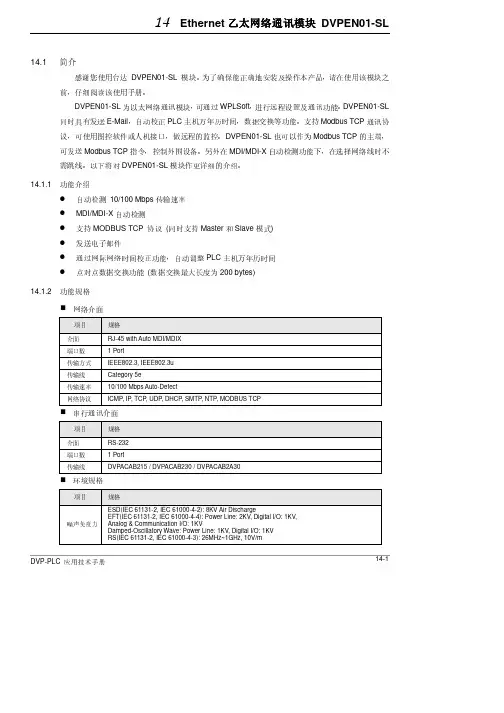
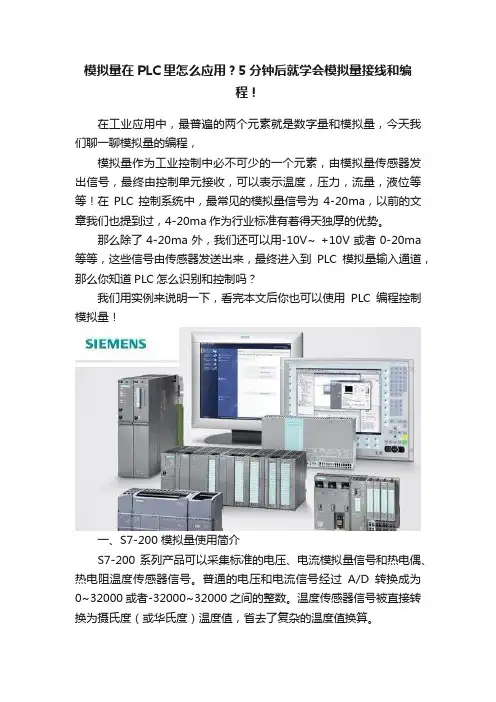
模拟量在PLC里怎么应用?5分钟后就学会模拟量接线和编程!在工业应用中,最普遍的两个元素就是数字量和模拟量,今天我们聊一聊模拟量的编程,模拟量作为工业控制中必不可少的一个元素,由模拟量传感器发出信号,最终由控制单元接收,可以表示温度,压力,流量,液位等等!在PLC控制系统中,最常见的模拟量信号为4-20ma,以前的文章我们也提到过,4-20ma作为行业标准有着得天独厚的优势。
那么除了4-20ma外,我们还可以用-10V~ +10V或者0-20ma 等等,这些信号由传感器发送出来,最终进入到PLC模拟量输入通道,那么你知道PLC怎么识别和控制吗?我们用实例来说明一下,看完本文后你也可以使用PLC编程控制模拟量!一、S7-200 模拟量使用简介S7-200系列产品可以采集标准的电压、电流模拟量信号和热电偶、热电阻温度传感器信号。
普通的电压和电流信号经过A/D转换成为0~32000 或者-32000~32000 之间的整数。
温度传感器信号被直接转换为摄氏度(或华氏度)温度值,省去了复杂的温度值换算。
S7-200系列可以提供的模拟量输出信号有-10V~ +10V之间的电压和0~20mA 的电流信号,能够满足大多数模拟量负载的需求。
S7-200系列的模拟量扩展模块选型灵活,用户可以根据实际需要选择使用CPU224XP集成的模拟量通道,或者使用4通道输入、8通道输入、2通道输出、4通道输出和输入输出混合模块。
224 XP在CPU上集成了两个模拟量输入端口和一个模拟量输出端口。
224 XP 的模拟量输入/输出通道的精度为 12位。
224 XP上的模拟量输入转换速度比模拟量扩展模块慢,因此要求高的场合请使用模拟量扩展模块。
分辨率是A/D模拟量转换芯片的转换精度,即用多少位的数值来表示模拟量。
S7-200模拟量模块的转换分辨率是12位,能够反映模拟量变化的最小单位是满量程的1/4096。
模拟量转换的精度除了取决于A/D转换的分辨率,还受到转换芯片的外围电路的影响。
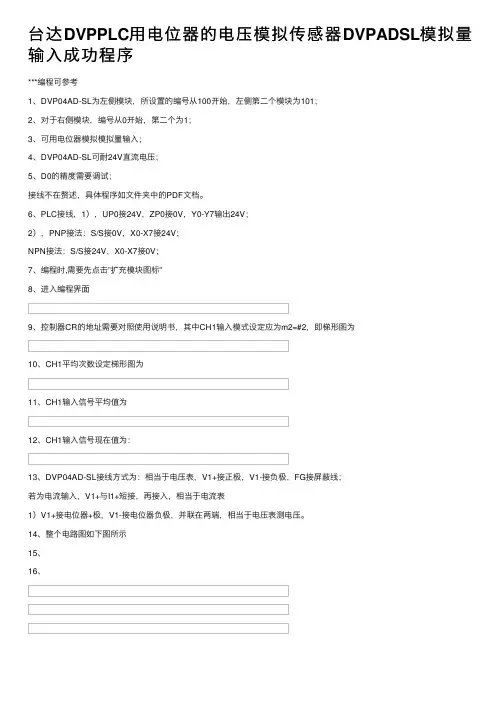
台达DVPPLC⽤电位器的电压模拟传感器DVPADSL模拟量输⼊成功程序
***编程可参考
1、DVP04AD-SL为左侧模块,所设置的编号从100开始,左侧第⼆个模块为101;
2、对于右侧模块,编号从0开始,第⼆个为1;
3、可⽤电位器模拟模拟量输⼊;
4、DVP04AD-SL可耐24V直流电压;
5、D0的精度需要调试;
接线不在赘述,具体程序如⽂件夹中的PDF⽂档。
6、PLC接线,1),UP0接24V,ZP0接0V,Y0-Y7输出24V;
2),PNP接法:S/S接0V,X0-X7接24V;
NPN接法:S/S接24V,X0-X7接0V;
7、编程时,需要先点击”扩充模块图标”
8、进⼊编程界⾯
9、控制器CR的地址需要对照使⽤说明书,其中CH1输⼊模式设定应为m2=#2,即梯形图为
10、CH1平均次数设定梯形图为
11、CH1输⼊信号平均值为
12、CH1输⼊信号现在值为:
13、DVP04AD-SL接线⽅式为:相当于电压表,V1+接正极,V1-接负极,FG接屏蔽线;
若为电流输⼊,V1+与I1+短接,再接⼊,相当于电流表
1)V1+接电位器+极,V1-接电位器负极,并联在两端,相当于电压表测电压。
14、整个电路图如下图所⽰
15、
16、。

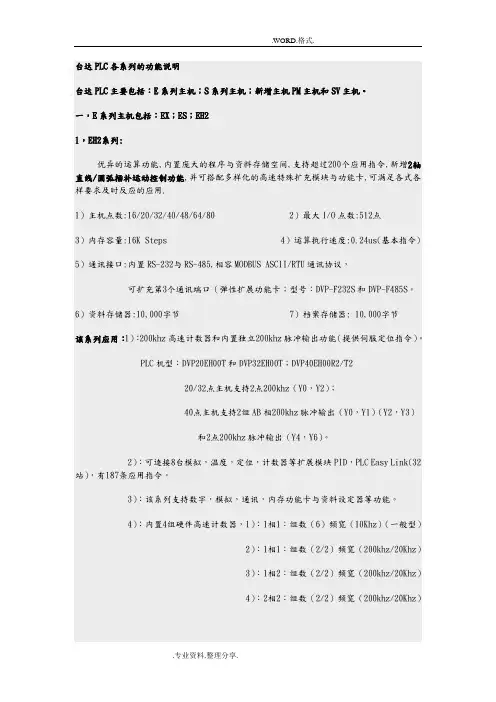
台达PLC各系列的功能说明台达PLC主要包括:E系列主机;S系列主机;新增主机PM主机和SV主机。
一,E系列主机包括:EX;ES;EH21,EH2系列:优异的运算功能,内置庞大的程序与资料存储空间,支持超过200个应用指令,新增2轴直线/圆弧插补运动控制功能,并可搭配多样化的高速特殊扩充模块与功能卡,可满足各式各样要求及时反应的应用.1)主机点数:16/20/32/40/48/64/80 2)最大I/O点数:512点3)内存容量:16K Steps 4)运算执行速度:0.24us(基本指令)5)通讯接口:内置RS-232与RS-485,相容MODBUS ASCII/RTU通讯协议,可扩充第3个通讯端口(弹性扩展功能卡;型号:DVP-F232S和DVP-F485S。
6)资料存储器:10,000字节 7)档案存储器: 10,000字节该系列应用:1):200khz高速计数器和内置独立200khz脉冲输出功能(提供伺服定位指令)。
PLC机型:DVP20EH00T和DVP32EH00T;DVP40EH00R2/T220/32点主机支持2点200khz(Y0,Y2);40点主机支持2组AB相200khz脉冲输出(Y0,Y1)(Y2,Y3)和2点200khz脉冲输出(Y4,Y6)。
2):可连接8台模拟,温度,定位,计数器等扩展模块PID,PLC Easy Link(32站),有187条应用指令。
3):该系列支持数字,模拟,通讯,内存功能卡与资料设定器等功能。
4):内置4组硬件高速计数器,1):1相1:组数(6)频宽(10Khz)(一般型)2):1相1:组数(2/2)频宽(200khz/20Khz)3):1相2:组数(2/2)频宽(200khz/20Khz)4):2相2:组数(2/2)频宽(200khz/20Khz)5):优异的运算能力:CPU+ASIC双处理器,支持浮点运算。
6):直线/圆弧补间运动功能支持最新开发的直线/圆弧插补运动控制指令,搭配高速脉冲输出功能,可以轻易达到两轴同时动作的控制要求。
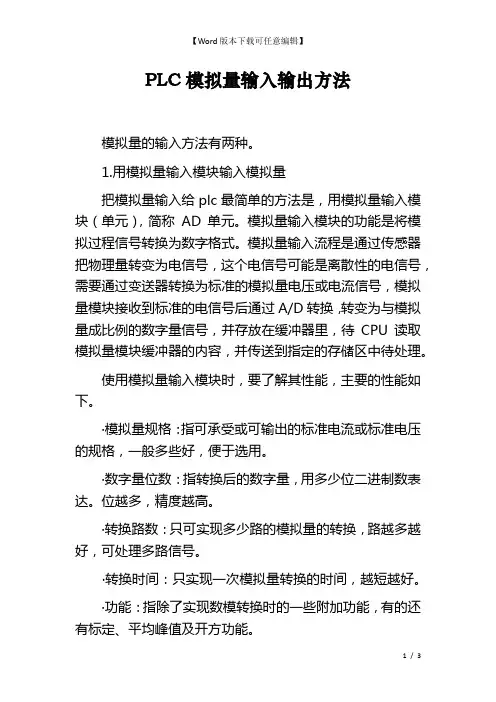
PLC模拟量输入输出方法模拟量的输入方法有两种。
1.用模拟量输入模块输入模拟量把模拟量输入给plc最简单的方法是,用模拟量输入模块(单元),简称AD单元。
模拟量输入模块的功能是将模拟过程信号转换为数字格式。
模拟量输入流程是通过传感器把物理量转变为电信号,这个电信号可能是离散性的电信号,需要通过变送器转换为标准的模拟量电压或电流信号,模拟量模块接收到标准的电信号后通过A/D转换,转变为与模拟量成比例的数字量信号,并存放在缓冲器里,待CPU读取模拟量模块缓冲器的内容,并传送到指定的存储区中待处理。
使用模拟量输入模块时,要了解其性能,主要的性能如下。
·模拟量规格:指可承受或可输出的标准电流或标准电压的规格,一般多些好,便于选用。
·数字量位数:指转换后的数字量,用多少位二进制数表达。
位越多,精度越高。
·转换路数:只可实现多少路的模拟量的转换,路越多越好,可处理多路信号。
·转换时间:只实现一次模拟量转换的时间,越短越好。
·功能:指除了实现数模转换时的一些附加功能,有的还有标定、平均峰值及开方功能。
2.用采集脉冲输入模拟量PLC可采集脉冲信号,可用于高速计数单元或特定输入点采集。
也可用输入中断的方法采集。
而把物理量转换为电脉冲信号也比较方便。
模拟量输出方法有三种。
1.用模拟量输出模块(单元)控制输出为使控制的模拟量能连续、无波动地变化,最好的方法是用模拟量输出模块。
模拟量输出模块的功能是将数字输出值转换为模拟信号,简称DA单元。
模拟量输出模块的参数有诊断中断、组诊断、输出类型选择(电压、电流或禁用)、输出范围选择及对CPU STOP模式的响应。
模拟量输出流程是:CPU把指定的数字量信号传送到模拟量模块的缓冲器中,模拟量模块通过D/A转换器,把缓冲器的内容转变为成比例的标准电压或电流信号,标准电压或电流驱动相应的执行器动作,完成模拟量控制。
使用模拟量输出模块时应按以下步骤开展:[1]选用。
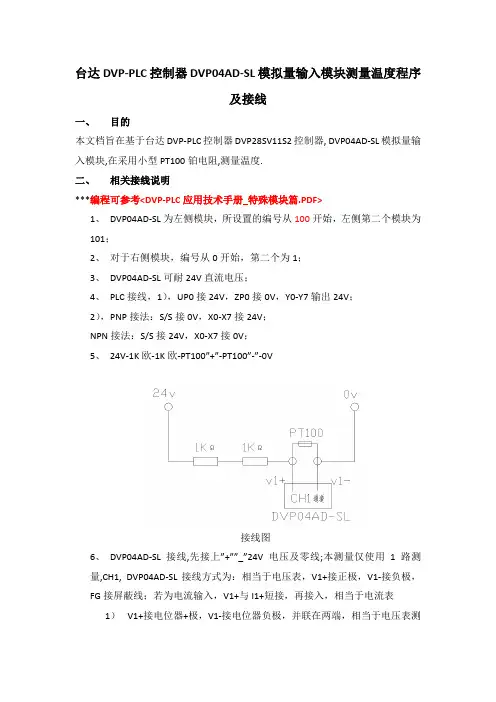
台达DVP-PLC控制器DVP04AD-SL模拟量输入模块测量温度程序及接线一、目的本文档旨在基于台达DVP-PLC控制器DVP28SV11S2控制器, DVP04AD-SL模拟量输入模块,在采用小型PT100铂电阻,测量温度.二、相关接线说明***编程可参考<DVP-PLC应用技术手册_特殊模块篇.PDF>1、DVP04AD-SL为左侧模块,所设置的编号从100开始,左侧第二个模块为101;2、对于右侧模块,编号从0开始,第二个为1;3、DVP04AD-SL可耐24V直流电压;4、PLC接线,1),UP0接24V,ZP0接0V,Y0-Y7输出24V;2),PNP接法:S/S接0V,X0-X7接24V;NPN接法:S/S接24V,X0-X7接0V;5、24V-1K欧-1K欧-PT100”+”-PT100”-”-0V接线图6、DVP04AD-SL接线,先接上”+””_”24V电压及零线;本测量仅使用1路测量,CH1, DVP04AD-SL接线方式为:相当于电压表,V1+接正极,V1-接负极,FG接屏蔽线;若为电流输入,V1+与I1+短接,再接入,相当于电流表1)V1+接电位器+极,V1-接电位器负极,并联在两端,相当于电压表测电压。
三、编程说明***编程可参考<DVP-PLC应用技术手册_特殊模块篇.PDF>1、DVP04AD-SL为左侧模块,所设置的编号从100开始,左侧第二个模块为101;2、对于右侧模块,编号从0开始,第二个为1;3、编程时,需要先点击”扩充模块图标”4、5、进入编程界面6、7、控制器CR的地址需要对照使用说明书,其中CH1输入模式设定应为m2=#2,即梯形图为,设置输入模式8、CH1平均次数梯形图为,3200存入D809、测量开始控制,X1接通,M1接通,开始读取相关通道数据10、CH1输入信号平均值为11、CH1输入信号现在值为:12、浮点数转换,平均值D40转换成浮点数,放入D60, 现在值D50转换成浮点数,放入D70, D80寄存器中的3200转换成浮点数,放入D20.13、平均值转换成实际电压14、现在值转换成实际电压15、X2重置测量,四、PT100铂电阻温度读数本测试系统,基于PT100铂电阻传感器,在PLC程序中,只能通过D0读取铂电阻两端的电压现在值,通过D6读取铂电阻两端的电压平均值,比如读数为1.447V,通过换算,可得出PT100此时的电阻值为128.3199574Ω,通过””PT100分度表””可查的此时的温度约为73.5℃.。
DVP-PLC特殊模块怎么使用DVP-PLC特殊模块怎么使用?成都永浩机电工程技术有限公司做了以下总结供大家参考:一、模拟输入模块DVP04AD/DVP06AD在自动化的领域中,有许多的测量单元,是以模拟信号的模式进行传送的动作,且以电压-10~10V 与电流-20~20mA 范围最为常见。
若要将模拟信号作为PLC 控制演算的参数,则需转换为数字量。
例如:电压-10~10V。
经由AD 模块的转换成为-8,000~+8,000 的数值范围后,PLC 再以FROM/TO 指令对AD 模块的CR 寄存器进行读写的动作,所传回至PLC 的信号为K-8,000~ K8,000 的数字量,即可提供PLC 进行运算处理。
DVP04AD (DVP06AD)模拟信号输入模块可接受外部4 (6)点模拟信号输入(电压或电流皆可),并将其转换成14 位的数字信号。
通过主机以指令FROM/TO 来读写模块内的数据,摸块内具有49 个CR (Control Register)寄存器,每个寄存器为16bits。
可经由配线选择电压输入或电流输入。
电压输入范围±10V (±8,000,分辨率为。
电流输入范围±20mA (±4,000,分辨率为5μA)。
二、模拟输出模块DVP02DA/DVP04DA在应用的领域中,有许多的控制信号,是以模拟信号的模式进行控制,且以0~10V 与0~20mA范围为最常见的信号范围。
因此需将PLC 数值数据转换为模拟信号来控制周边装置。
例如:PLC 数值数据0~4,000 的范围。
经由DA 模块的转换成为0~10V 的电压值,所输出的电压即可提供周边模拟装置进行控制。
DVP02DA (DVP04DA) 模拟信号输出模块,可通过DVP-PLC 主机程序以指令FROM/TO 来读写DVP02DA (DVP04DA) 模拟信号输出模块的数据。
模块内具有49 个CR (Control Register) 寄存器,每个寄存器有16bits。
1.首先要清楚的是,什么指令能用于模拟量输入。
查“DVP-ES2操作手册——程序篇”API指令一览表,找到有“FROM”、“T O”两条指令相关,分别为“扩展模块CR数据读出”和“扩展模块CR数据写入”。
CR是控制寄存器的缩写。
于是,再翻到有关页面,查看其详细说明,得到FROM指令的格式是:FROM m1 m2 D n,参见图1。
m1:扩展模块所在的编号,取值范围0~7;m2:欲读取扩展模块的CR编号;D:读出数据保存位置;n:一次读取数据的笔数。
①再继续看其解释,从次页知道,扩展模块的编号与其与主机的位置有关;倘若只有一台扩展模块,则其编号为0,此点不存在问题。
读出数据的保存位置,则是在PLC主机上的,由编程者指定,也不存在理解困难;而n,也不是问题。
②问题是,图1中的m2,K29是如何来的呢?或者说,模块内的数据储存在哪里、能否利用编程软件直接观察到?查“DVP-ES2操作手册-硬件篇”有模拟量输入/输出模块配线,却不但没有回答上述问题,反而增加了一个新的疑问:可以采用电压或电流信号输入,则是如何设定的呢?硬件上没有见到相关的设置开关。
③从而,现在的工作是,必须确定是否有模块的操作手册。
从台达网站的下载页面,看到了有模块资料,于是下载了“DVP-ES2操作手册-模块篇”,其第1部分就是“模拟量输入模块 DVP04AD-E2”的介绍。
2.输入信号的读出于是,知道了CR#2~#5为输入模式设定,CR#8~#11为通道信号的平均次数设定,CR#12~#15为通道输入信号平均值显示,CR#20~#23通道输入信号现在值显示。
另外,主机的寄存器D9900~D9999,寄存对应输入信号平均值。
选1#通道(CH1)作试验,可得程序如图2:①将模块与主机连接,PLC通电,发现模块的“错误指示灯”点亮;先不管他,程序能正常输入。
后将模块的24V接通,显示正常、“错误指示灯”熄灭。
②为了简便,拟直接采用1.5V电池作为信号,故采用了模式1。
***编程可参考<DVP-PLC应用技术手册_特殊模块篇.PDF>
1、DVP04AD-SL为左侧模块,所设置的编号从100开始,左侧第二个模块为101;
2、对于右侧模块,编号从0开始,第二个为1;
3、可用电位器模拟模拟量输入;
4、DVP04AD-SL可耐24V直流电压;
5、D0的精度需要调试;
接线不在赘述,具体程序如文件夹中的PDF文档。
6、PLC接线,1),UP0接24V,ZP0接0V,Y0-Y7输出24V;
2),PNP接法:S/S接0V,X0-X7接24V;
NPN接法:S/S接24V,X0-X7接0V;
7、编程时,需要先点击”扩充模块图标”
8、进入编程界面
9、控制器CR的地址需要对照使用说明书,其中CH1输入模式设定应为m2=#2,即梯形图
为
10、CH1平均次数设定梯形图为
11、CH1输入信号平均值为
12、CH1输入信号现在值为:
13、DVP04AD-SL接线方式为:相当于电压表,V1+接正极,V1-接负极,FG接屏蔽线;
若为电流输入,V1+与I1+短接,再接入,相当于电流表
1)V1+接电位器+极,V1-接电位器负极,并联在两端,相当于电压表测电压。
14、整个电路图如下图所示
15、
16、。
台达DVP-PLC控制器DVP04AD-SL模拟量输入模块测量拉力压力程序及接线一、目的本文档旨在基于台达DVP-PLC控制器DVP28SV11S2控制器, DVP04AD-SL模拟量输入模块,在采用测力传感器,通过拉压运动,测量拉力及压力.二、传感器及变送器安装采用S型传感器,安装如图所示,有线一段为固定端,另一端为测量端。
其中,固定端应该固定不动,只在运动件的带动下运动,进行力的测量。
变送器的信号输入接SHG\EXC+\EXC-\SIG+\SIG-\TEDS接线端,再接入24V+,24v供电,再CA+,接入模拟量模块+,CA-接入模拟量模块—。
即可完成接线。
二、相关接线说明***编程可参考<DVP-PLC应用技术手册_特殊模块篇.PDF>1、DVP04AD-SL为左侧模块,所设置的编号从100开始,左侧第二个模块为101;2、对于右侧模块,编号从0开始,第二个为1;3、DVP04AD-SL可耐24V直流电压;4、PLC接线,1),UP0接24V,ZP0接0V,Y0-Y7输出24V;2),PNP接法:S/S接0V,X0-X7接24V;NPN接法:S/S接24V,X0-X7接0V;5、DVP04AD-SL接线,先接上”+””_”24V电压及零线;本测量仅使用1路测量,CH1, DVP04AD-SL接线方式为:相当于电压表,V1+接正极,V1-接负极,FG接屏蔽线;若为电流输入,V1+与I1+短接,再接入,相当于电流表1)V1+接电位器+极,V1-接电位器负极,并联在两端,相当于电压表测电压。
三、编程说明***编程可参考<DVP-PLC应用技术手册_特殊模块篇.PDF>1、DVP04AD-SL为左侧模块,所设置的编号从100开始,左侧第二个模块为101;2、对于右侧模块,编号从0开始,第二个为1;3、编程时,需要先点击”扩充模块图标”4、5、进入编程界面6、7、触摸屏通讯程序,如下图8、在触摸屏上设置开始键,对应M110,9、控制器CR的地址需要对照使用说明书,其中CH1输入模式设定应为m2=#2,即梯形图为,设置输入模式为0-±10V。
台达D V P L C用电位器的电压模拟传感器
D V P S L模拟量输入成
功程序
集团档案编码:[YTTR-YTPT28-YTNTL98-UYTYNN08]
***编程可参考<D V P-P L C应用技术手册_特殊模块篇.P D F>
1、DVP04AD-SL为左侧模块,所设置的编号从100开始,左侧第二个模块为101;
2、对于右侧模块,编号从0开始,第二个为1;
3、可用电位器模拟模拟量输入;
4、DVP04AD-SL可耐24V直流电压;
5、D0的精度需要调试;
接线不在赘述,具体程序如文件夹中的PDF文档。
6、PLC接线,1),UP0接24V,ZP0接0V,Y0-Y7输出24V;
2),PNP接法:S/S接0V,X0-X7接24V;
NPN接法:S/S接24V,X0-X7接0V;
7、编程时,需要先点击”扩充模块图标”
8、进入编程界面
9、控制器CR的地址需要对照使用说明书,其中CH1输入模式设定应为m2=#2,即梯形图
为
10、CH1平均次数设定梯形图为
11、CH1输入信号平均值为
12、CH1输入信号现在值为:
13、DVP04AD-SL接线方式为:相当于电压表,V1+接正极,V1-接负极,FG接屏蔽线;
若为电流输入,V1+与I1+短接,再接入,相当于电流表
1)V1+接电位器+极,V1-接电位器负极,并联在两端,相当于电压表测电压。
14、整个电路图如下图所示
15、
16、。